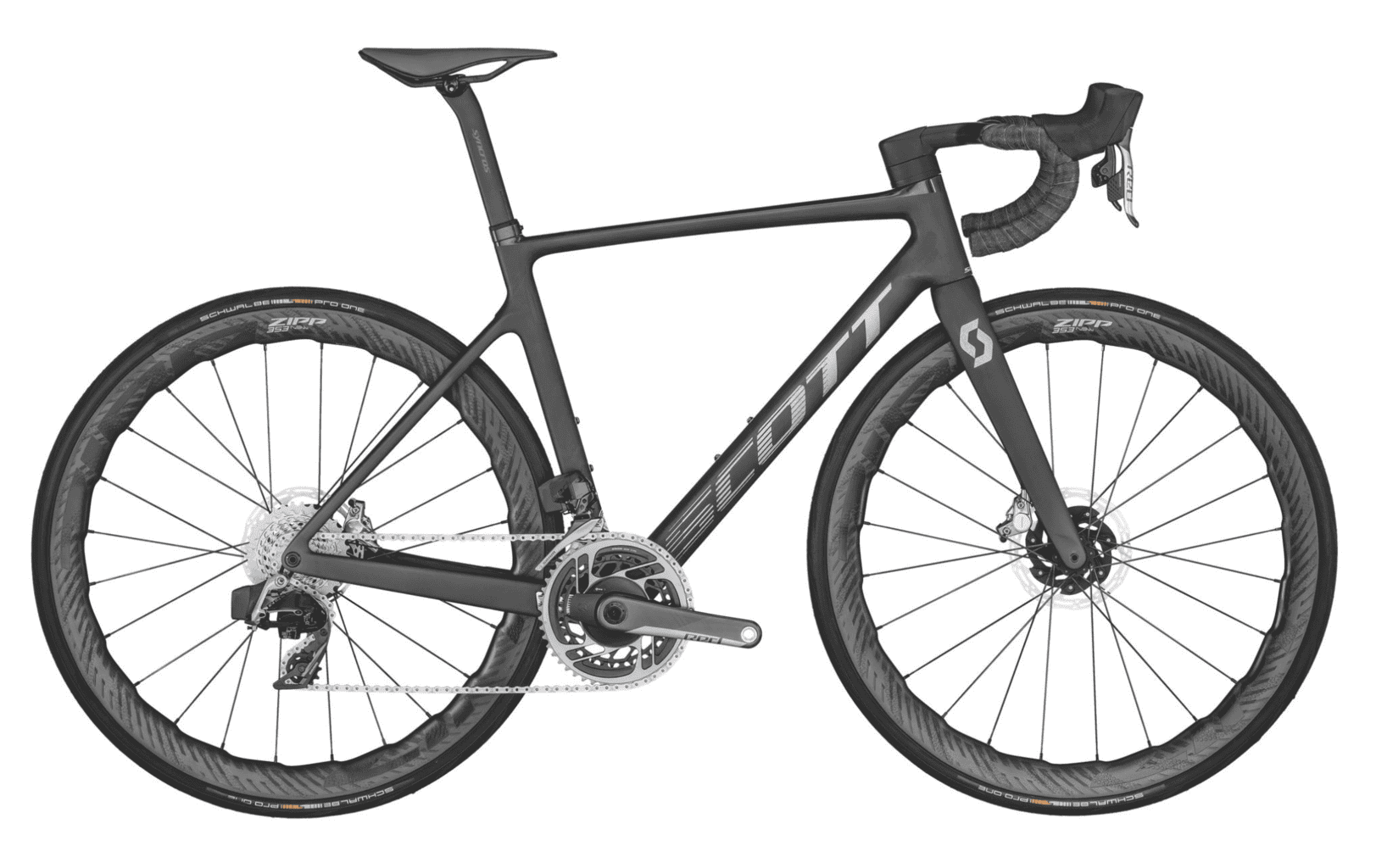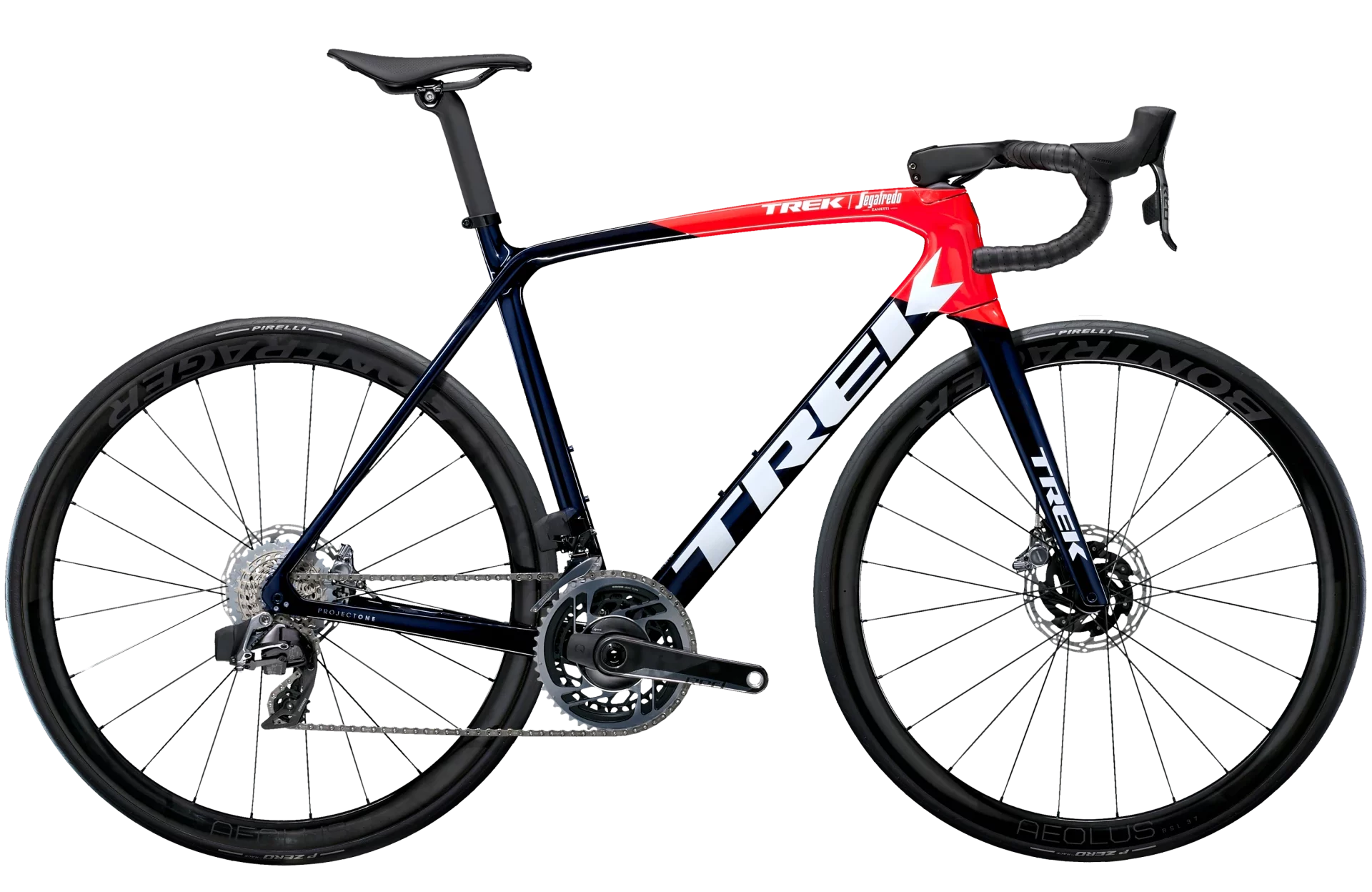In this article, I’ll guide you through a comparison between the Scott Addict RC and Trek Emonda; both popular road bikes among cyclists.
I’ll walk through the Scott Addict RC and Trek Emonda models lineup, their specifications, and retail pricing (USD). I’ll explain the carbon fiber technology used (Scott High Modulus Carbon vs Trek OCLV), and unique frameset features for each bike.
The goal is to help you get a better understanding before you make your final purchasing decision.
| Scott Addict RC | Trek Emonda | |
|---|---|---|
| Type of bike | All-rounder | All-rounder |
| Frame material | HMX-SL carbon HMX carbon HMF carbon | OCLV 800 carbon OCLV 500 carbon |
| Frame sizes | 47, 49, 52, 54, 56, 58, 61 | 47, 50, 52, 54, 56, 58, 60, 62 |
| Groupset | Shimano, SRAM (12-speed) | Shimano, SRAM (12-speed) |
| Brakes | Hydraulic disc | Hydraulic disc |
| Cabling | Internal | Internal |
| Price (USD) | $4,799 to $15,999 | $4,999 to $13,199 |
Scott Addict RC

The Scott Addict RC Ultimate is a top-of-the-line model made from the superlight HMX SL Carbon. The Scott Addict RC Pro is next in line with the HMX Carbon. Both models have a fully integrated, one-piece carbon handlebar.
Further down the line are five Scott Addict RC models built with the HMX Carbon. They use a two-piece aluminum handlebar, and the cables are fully hidden. RC stands for Racing Concept, and the Addict RC is Scott’s performance racing bike.
There’s also a women-specific Scott Contessa Addict RC similar to the standard version, except for the touchpoints, saddles, handlebars, and compact cranksets.
| Model | Frame material | Groupset | Wheelset | Retail price (USD) |
|---|---|---|---|---|
| Scott Addict RC Ultimate | Carbon (HMX-SL) | SRAM Red eTap AXS | Zipp 353 NSW | $15,999 |
| Scott Addict RC Pro | Carbon (HMX) | Shimano Dura-Ace Di2 (R9200) | Zipp 303SE | $9,999 |
| Scott Addict RC 10 | Carbon (HMX) | SRAM Force eTap AXS | Syncros Capital 1.0 35 | $7,599 |
| Scott Addict RC 15 | Carbon (HMX) | Shimano Ultegra Di2 (R8100) | Syncros Capital 1.0 35 | $6,799 |
| Scott Addict RC 20 | Carbon (HMX) | SRAM Force eTap AXS | Syncros RP2.0 | $6,299 |
| Scott Addict RC 30 | Carbon (HMX) | SRAM Rival eTap AXS | Syncros RP2.0 | $5,299 |
| Scott Addict RC 40 | Carbon (HMX) | Shimano 105 Di2 (R7100) | Syncros RP2.0 | $4,799 |
Scott Addict RC vs others
Trek Emonda

The Trek Emonda is a lightweight bike for the high mountains.
The lightest Trek Emonda frame weighs less than 700g using Trek’s OCLV 800 carbon. This is the bike Richie Porte rode to his third place in the 2020 Tour de France.
The SLR is the lightest and most expensive atop the Trek Emonda models. There are six Emonda SLR options, specced electronic shifting groupsets from SRAM or Shimano.
Next in line is the SL, the mid-range, more budget-friendly option. It has the same frame design and geometry as the SLR but uses the OCLV 500 carbon instead. The groupset choices are Shimano Ultegra Di2, Shimano 105 Di2, SRAM Force AXS, or SRAM Rival AXS.
The Trek Emonda SLR and SL framesets are also available separately.
| Model | Frame material | Groupset | Wheelset | Retail price (USD) |
|---|---|---|---|---|
| Trek Emonda SLR 9 AXS | OCLV 800 carbon | SRAM Red eTap AXS | Bontrager Aeolus RSL 37 | $13,199 |
| Trek Emonda SLR 9 | OCLV 800 carbon | Shimano Dura-Ace Di2 (R9200) | Bontrager Aeolus RSL 37 | $12,749 |
| Trek Emonda SLR 7 AXS | OCLV 800 carbon | SRAM Force eTap AXS | Bontrager Aeolus Pro 37 | $9,699 |
| Trek Emonda SLR 7 | OCLV 800 carbon | Shimano Ultegra Di2 (R8100) | Bontrager Aeolus Pro 37 | $8,999 |
| Trek Emonda SLR 6 AXS | OCLV 800 carbon | SRAM Rival eTap AXS | Bontrager Aeolus Pro 37 | $8,399 |
| Trek Emonda SLR 6 | OCLV 800 carbon | Shimano 105 Di2 (R7100) | Bontrager Aeolus Pro 37 | $7,699 |
| Trek Emonda SL 7 AXS | OCLV 500 carbon | SRAM Force eTap AXS | Bontrager Aeolus Pro 37 | $6,699 |
| Trek Emonda SL 6 | OCLV 500 carbon | Shimano 105 Di2 (R7100) | Bontrager Aeolus Elite 35 | $4,999 |
Trek Emonda vs others
Scott vs Trek carbon fiber
Scott High Modulus Carbon
Scott implements two primary types of carbon fiber technology in their bicycle frame construction; HMX-SL, HMX, and HMF carbon.
- HMX-SL (High Modulus Xtreme, Super Light) carbon is the pinnacle of Scott’s carbon fiber technology. This innovative blend of carbon fiber is designed for ultimate stiffness and minimal weight. Scott uses HMX-SL Carbon in their highest-end models, such as the premium version of the Scott Addict RC Ultimate and Foil RC Ultimate road bike. These bikes, with HMX-SL Carbon frames, are the go-to choice for professional cyclists competing in world-class races.
- HMX carbon is a level below the HMX-SL, and is still a top-tier carbon material offering a fantastic blend of stiffness and lightweight construction, albeit not as light or rigid as the HMX-SL. It’s an excellent choice for serious and experienced cyclists looking for a high-performance bike without the additional premium.
- HMF (High Modulus Fiber) carbon, may not be as light or stiff as HMX carbon, but it’s still a superior material that contributes to a robust, light, and efficient ride. Scott uses HMF carbon in their bikes that strike a balance between affordability and performance.
Trek OCLV carbon
The OCLV (Optimum Compaction, Low Void) carbon is a proprietary carbon fiber manufacturing technology developed by Trek.
- Optimum Compaction refers to the heat and pressure applied during the curing process to squeeze out excess resin and ensure that the carbon layers are compacted to the optimal density.
- Low Void refers to the goal of reducing microscopic air pockets or voids that can occur in the carbon fiber and create weaknesses.
One of the key advantages of OCLV carbon is its ability to achieve an optimal balance between stiffness, strength, and weight. Trek engineers carefully tune the carbon layup and utilize varying modulus carbon fibers to create stiff frames in certain areas to maximize power transfer while maintaining compliance in other areas to enhance comfort and ride quality.
The OCLV carbon is available in 800 and 500 series.
- OCLV 800 is the highest-grade carbon fiber used by Trek. The carbon modulus is higher in OCLV 800, making it stiffer and lighter. The manufacturing process is more refined, using more advanced carbon and resins, leading to a bike frame that provides top performance levels for stiffness, weight, and strength. OCLV 800 is used in all models with SLR.
- OCLV 500 is a lower-grade carbon but still offers a high level of performance. It has a slightly lower carbon modulus, meaning it’s a bit less stiff and heavier than OCLV 800. OCLV 800 is used in all models with SL.
It’s worth noting that the different OCLV grades don’t only refer to the material itself, but also to the manufacturing techniques used to form the carbon fiber into bike frames. Higher-grade carbon requires more precise manufacturing techniques to take full advantage of its superior material properties.
Frameset technologies and innovations
Scott Addict RC and Trek Emonda framesets incorporate advanced technologies to enhance their bikes’ performance and ride characteristics.
Here’s an overview of the technologies used in each bike model.
Scott Addict RC
| Name | Description |
|---|---|
| Oversize Bottom Bracket | The Addict RC features an oversized down tube and bottom bracket intersection, among the widest on the current road bike market. This extensive cross-section and smooth transition handle loads effectively, reducing unwanted frame flex and ensuring efficient power transfer to the drivetrain. |
| Hollow Frame Structure | The entire frame set of Addict RC is built with a hollow structure and has an immaculately clean inside, which significantly reduces the overall weight. |
| One-Piece Handlebar | The Syncros Combo Creston IC handlebar is neat, with all cables completely routed internally through the bar, headset, and into the frame as part of Scott’s new Integrated Cable Routing (ICR). Collaborating with GebioMized, the handlebar design optimizes ergonomics for riders. |
| Evo-Lap Technology | Scott applies Evo-Lap technology in designing the Addict RC, using Finite Element Analysis (FEA) software to simulate different forces on the frame and optimize the carbon lay-up. By modeling the frame and testing stress distribution in different areas, Scott has optimized carbon layers throughout the frame, creating a lightweight yet resilient structure. |
Trek Emonda
| Name | Description |
|---|---|
| OCLV Carbon | Optimum Compaction, Low Void (OCLV). A carbon fiber technology used in Trek frames. Employs advanced layup techniques and precise carbon compaction to create lightweight, strong frames with a balanced blend of stiffness and compliance. Available in two grades; OCLV 800 and 500. A higher number indicates a higher grade carbon. |
| H1.5 geometry | Trek’s geometry design that strikes a balance between aggressive racing positioning (H1) and rider comfort (H2). H1.5 geometry provides a slightly more relaxed riding position than the racier H1 geometry, making it suitable for a wider range of riders. |
| Project One | Trek’s customization program allows riders to create personalized and unique bikes. With Project One, riders can customize various aspects of their bikes, including frame color, paint scheme, components, drivetrain, wheels, and other details. |
Where to buy
Scott retailers
- Scott retailers. Use this tool to find your nearest Scott retailers.
- Scott distributors. Use this tool to find your local Scott distributors.
Trek shops
- Trek online shops. Australia, Austria, Canada, Germany, Netherlands, United Kingdom, United States
- Trek retailers. Use this tool to find your nearest Trek retailers.

Alex Lee is the founder and editor-at-large of Mr. Mamil. Coming from a professional engineering background, he breaks down technical cycling nuances into an easy-to-understand and digestible format here.
He has been riding road bikes actively for the past 12 years and started racing competitively in the senior category during the summer recently.